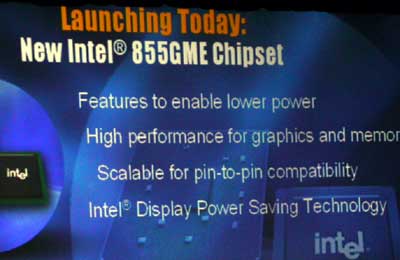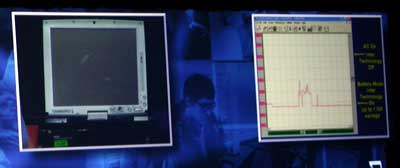Intel Developer Forum Fall 2003 - Day 2: All About Mobile
by Derek Wilson on September 17, 2003 5:19 PM EST- Posted in
- IT Computing
Updates for Centrino
Intel is definitely keeping up the pace they set for themselves yesterday with the Extreme Edition announcement. Anand Chandrasekher's first revelation was a new mobile chipset for the Pentium-M (Centrino processor), the 855GME, which has some very nice features.
First and foremost, the 855GME finally supports DDR333, which should instantly increase performance. Intel lists the chipset as having an "updated" graphics core, although in reality it is the same graphics core from the previous chipset. The difference here is that the graphics core runs at 250MHz (up from 200MHz) and it can run at either 200 or 250MHz depending on workload. Intel still has much to improve on in terms of 3D performance, however if you don't play any games then their integrated graphics is one of your better options because of some of the other features associated with it.

One such feature is Display Power Saving Technology (DPST); DPST works only with the integrated graphics core to dynamically adjust the brightness of the back light depending on the image being displayed on the screen. Since the hardware knows what is being displayed on the screen by looking at the contents of the frame buffer, it is possible for you to run some mathematical algorithms on that data to determine the optimal back light settings on a pixel-by-pixel basis in order to produce the best balance of image quality and power.
The theory is that although you need your back light to be as bright as possible and relatively uniform when you have a picture of a bright sky on your screen, when you are looking at a normally lit environment there will be some parts of the screen where you don't need as bright of a back light and thus can save power by lowering the brightness.

Intel demoed the feature by turning it on while an 855GME based laptop displayed a still image; power consumption from the display dropped from 5W to 3W with no perceivable loss in visual quality (or course, it was on a giant display across the room and being filmed by a camera).
The next demo involved displaying a video on the screen, which was fairly dark initially but contained an explosion mid-way through. We were able to see from the power consumption graph that power usage went up when the image being displayed was brighter (e.g. the explosions) - indicating that the technology was doing what it was supposed to do and increasing the brightness of the back light only when necessary.
The DPST does not require (in its current form) any special support other than the OEM simply turning the feature on; you do have to be using the integrated graphics core, but other than that you don't need to have a special LCD panel. Availability of DPST is immediate as the 855GME chipset has already begun shipping.










7 Comments
View All Comments
Anonymous User - Friday, September 19, 2003 - link
Anonymous User - Friday, September 19, 2003 - link
Anonymous User - Friday, September 19, 2003 - link
Anonymous User - Friday, September 19, 2003 - link
Anonymous User - Friday, September 19, 2003 - link
Anonymous User - Thursday, September 18, 2003 - link
Where is Anand Shimpi? Was expecting a write up from him.Anonymous User - Thursday, September 18, 2003 - link
Check out booth 16 in the Demo Pavilion under the 400 sign! Pics of Tumwater running with PCI Express x16 gfx to be had there!